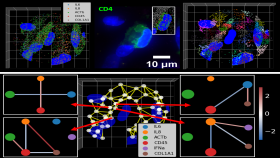This article is a repost of a UNICEF stories of innovation article regarding UNICEF's Wearables for Good Challenge
By Pilar Lagos, UNICEF, Stories of Innovation
On 8 September 2015, Blair Palmer, UNICEF Innovation San Francisco Lab Lead and I chatted with Raja Schaar, Lecturer & Design Instructor at Georgia Tech about her teaching methodologies and how she challenged her students to build wearables keeping social impact in mind.
Raja Schaar created the first prototype course focused on healthcare wearables that will hopefully, in future iterations, become a model for classes taught elsewhere. “Health care presents unique challenges related to regulatory compliance, privacy, and security. This is a fast-moving field, and as opportunities in bioinformatics, telehealth, and device development present themselves, our students need to be positioned to compete and contribute,” Schaar says.
Earlier this year, Schaar travelled to Galway, Ireland to teach a class on “Wearables for Healthcare” as part of a study abroad program. Thirty-two Georgia Tech students from the Department of Biomedical Engineering (BME) embarked on the journey too. When Schaar heard about UNICEF’s Wearables for Good design challenge, she encouraged students to submit their ideas.
To her surprise, a team from her class was selected as one of the 10 Wearables for Good challenge finalists. The team, Communic-Aid, designed a wearable device that facilitates record keeping, aids in the tracking of medications that have been distributed in a post-disaster context, and allows the patient to take part in their treatment.
On 19 October 2015, Blair Palmer was invited as guest lecturer at Georgia Tech to talk with undergraduate Biomedical Engineering & Design students about why wearables and sensor technology are part of UNICEF Innovation’s agenda. She also discussed what it takes to scale technology for good, including the criteria to do so, how budding designers and engineers can think about the context of social impact in their work, and to create things that are not only nice to have, but that people need to have.
Palmer encouraged students to think beyond the single point of influence in wearable and sensor technology and how to empower users by curating the right data and information insight that sensor technology provide. She challenged them, “How can you think about what people already use, what they want to use, and how the information these tools can provide can be intuitive, useful, and remove complexity? At the end of the day, technology has to deliver value by enhancing the way we experience the world around us.”
Below, read our interview with Raja Schaar:
What methodology did you use to inspire your students?
Raja Schaar (RS): Keep it fun. We were dealing with challenging content in a short amount of time; we compressed a 15-week semester into 5 weeks. Also, engineering students tend to be very serious and focused. I wanted to disrupt that by introducing a few games and improv activities. I also used traditional design thinking methodologies to spur creativity and relied on mood boards to keep students inspired and grounded.
Where did your students find their inspiration to develop their ideas?
RS: It took over a week before teams settled on a defined a problem. We started with a mind mapping exercise using the categories established by the Wearables for Good design challenge. We also scoped media, TED talks, and the blogosphere for more informative stories on real-world problems and populations. Since wearable devices sync with big data, we also looked for issues that could use better data. Students worked on the development of personas based on health profiles, location, current events, environmental statistics, and looked for reports from NGOs and other groups working in the same field. They developed mood boards to visualize their research and stay on track. They looked at context, related and existing products, user-centered design, and style.
How did they respond to it?
RS: For the most part, students were enthusiastic and they loved learning something new. Only a few students had thought about wearables as a part of the design discipline, which has so much potential. Seven students had experience with circuits and a few knew about coding. The learning curve was enormous. It was definitely challenging, but whenever the students got their code to run, their sensors to measure, or successfully soldered a component to a microcontroller, they were visibly elated. They were using SnapChat, Twitter, and Facebook to document their progress. I love it when students get a sense of accomplishment and pride in learning.
Students were also excited about working on a project in the social innovation space. Georgia Tech’s undergraduate Biomedical Engineering program attracts mostly women. Sixty percent of our entering students are women and that ratio was reflected in my course. As a result, the students were jazzed about focusing on women and children. We were able to have deep discussions on issues that impact women globally, from sexual/reproductive health to trafficking and abuse, and empowering women through education. Being able to have mature conversations with passionate teams was refreshing.
Why do you think universities are not focusing on healthcare wearables when it seems that there is a high demand of healthcare wearables in the market?
RS: That’s a tough question, but I think it has to do with flexibility of Higher Education. Engineering program curriculum requirements are full to overflowing with required courses. A class like wearables for healthcare is seen as a depth elective. While students are required to take courses in circuits, courses are more theoretical than project-based. Project-based design courses are time-consuming and expensive for the program and the students. So adding a course like this isn’t taken lightly.
In the Industrial Design program at Georgia Tech, there’s a course on wearables, a course on interactive products, and a separate course on healthcare design. Each course lives separately and has its own complexity. What’s really cool is when you combine the three disciplines because you end up with an opportunity to take information from the body, read it through an interactive device, and use that data to empower patients and healthcare providers with information on how to prevent, manage, diagnose, and/or treat illness. When you have students who are knowledgeable on all three disciplines: 1) understand the body 2) have a basic handle on the design process 3) familiarity with sensors and microcontrollers and coding, and then combine that with a strong desire to improve health and well-being, you’re able to leverage their expanded skill-set to effectively apply knowledge.
What were the challenges?
RS: The program was based in Ireland which was a blessing and curse. Here we were doing a project focused on the developing world, but we had no direct interaction with people living in resource-constrained environments. We also had challenges of time and access to the university’s building. Also, in the U.S., the expectation is to work around the clock. In Ireland, they close the campus at 10 pm. Students worked as much as they could within a time frame.
Had there not been a Wearables for Good challenge, what would have been the next steps to develop these wearables?
RS: We have a few avenues I’ve been discussing with the students. CreateX is a GA Tech initiative to encourage entrepreneurship and innovation. Idea to Prototype is a course structured as a directed student where student get research credit to work on prototype development for their own project ideas. We also have 2 campus-wide competitions that BME projects have done well with: INVENTURE Prize at GA Tech and Ideas 2 Serve.
Do you partner with tech companies?
RS: No yet, but I’d love to! We have a few health care industry partners for our capstone course, but I’d like to work with some design and tech companies to help with the specific opportunities related to wearables. We just got a large donation from Texas Instruments to build an interdisciplinary makerspace on campus.
As some of you might know, UNICEF, ARM, and frog announced the Wearables for Good challenge winners last week at SLUSH, a tech event in Helsinki. The winners are SoaPen, a wearable soap that helps limit the spread of infectious viruses by encouraging hand washing for children and KhushiBaby, a necklace that stores electronic health data to track child immunization.
You can read more about the 10 finalists here: http://wearablesforgood.com/finalists/
You can read about the winners here: http://wearablesforgood.com/winners/
The original UNICEF article with Raja Schaar is linked HERE.
Media Contact
Walter Rich
Communications Manager
Wallace H. Coulter Department of Biomedical Engineering
Georgia Institute of Technology
Keywords
Latest BME News
Courses in the Wallace H. Coulter Department of Biomedical Engineering are being reformatted to incorporate AI and machine learning so students are prepared for a data-driven biotech sector.
Influenced by her mother's journey in engineering, Sriya Surapaneni hopes to inspire other young women in the field.
Coulter BME Professor Earns Tenure, Eyes Future of Innovation in Health and Medicine
The grant will fund the development of cutting-edge technology that could detect colorectal cancer through a simple breath test
The surgical support device landed Coulter BME its 4th consecutive win for the College of Engineering competition.
New research from Georgia Tech helps doctors predict how therapies will interact with a child's immune system, potentially improving outcomes and reducing risks.
Georgia Tech researchers reveal the dynamic role of inhibitory neurons in spatial memory and learning








